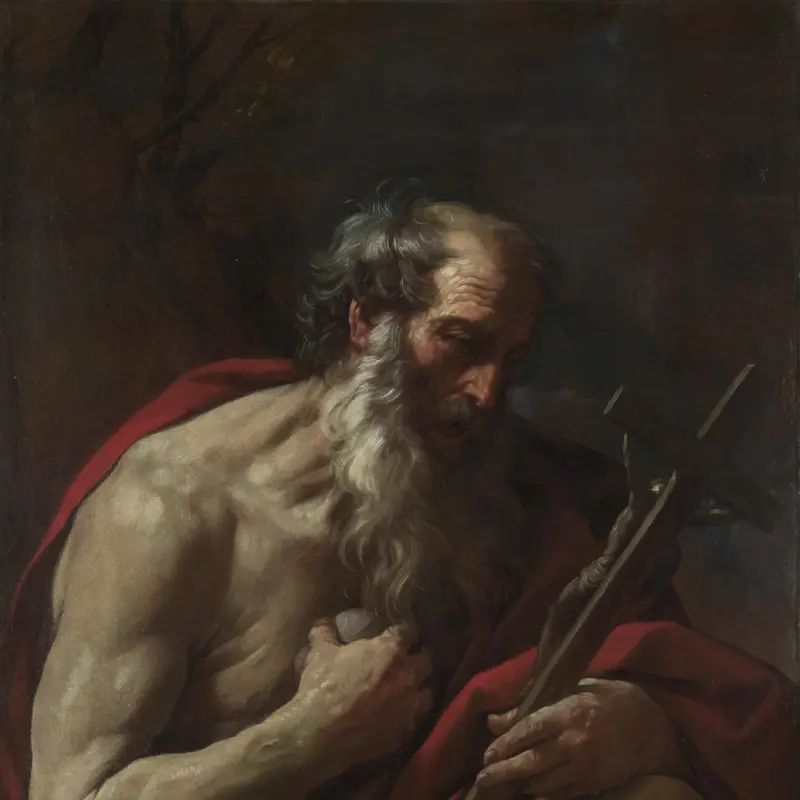Reni was trained by Denys Calvaert, and then probably in the Carracci workshop. He spent 1602-13 in Rome, where Domenichino had also arrived. Reni is reputed to have met (and quarrelled with) Caravaggio there.
Many of his best known works were painted in Rome, including the ceiling fresco, 'Aurora' (Casino Rospigliosi), carried out before 1614 for Cardinale Scipione Borghese. By 1613 Reni had returned to Bologna, and was largely active there until his death. He ran a busy studio engaged on commissions from many Italian cities.
Guido Reni
1575 - 1642
Works by Guido Reni
(Showing 6 of 11 works)
This scene depicts an intimate moment between Christ and Saint John the Baptist, here identified by his camel-skin garment and reed cross.The pair are more frequently portrayed meeting as young children, in an episode drawn from biblical apocrypha, or during Christ’s baptism, which was performed...
Not on display
Lot and his daughters are shown fleeing the sinful city of Sodom, forewarned by God of its destruction (Genesis 19). The family are in a moment of conversation, perhaps contemplating their next move. Conspicuously absent are details typically associated with the subject, such as Sodom burning in...
Saint Jerome (about 342–420 AD) was a theologian, writer and hermit, famous for producing what is considered to be the first Latin translation of the Bible, known as the Vulgate. The saint is depicted here with a number of identifying attributes: a crucifix refers to his religious contemplation d...
Saint Mary Magdalene is here depicted with eyes raised heavenward, a sign of her devotion and penance. The Gospels describe Mary of Magdala as one of Christ’s followers, a witness to his burial and resurrection. Mary Magdalene was later identified with another biblical figure, an unnamed woman un...
An apocryphal addition to the Old Testament describes how two lecherous elders threatened to accuse Susannah, a beautiful young woman, of adultery – a crime punishable by death – if she did not give in to their desires. Guido Reni here illustrates the episode: one man grabs at Susannah’s robes an...
The Adoration of the Shepherds is a late altarpiece by Guido Reni. Nearly five metres high without its frame, it is one of the largest paintings in the National Gallery’s collection.In a stable in Bethlehem, a group of shepherds gather around the newborn Christ. Reni has staged a night-time scene...
Paintings of the coronation of the Virgin Mary typically show her being crowned by Christ and God the Father, often accompanied by the Holy Ghost in the form of a dove. This work, however, mixes elements of the coronation with those of Mary’s assumption (when angels carried her body and soul to h...
This painting depicts the mythological story of Europa, daughter of the King of Tyre, who, while playing on the seashore one day, was approached by a docile bull. Draping a flower garland on its horns, Europa unsuspectingly climbed onto its back. The bull, who was in fact the god Jupiter in disgu...
Guido Reni and Studio
In this monumental painting, Venus, the goddess of love, is attended by the Three Graces, who carefully fasten her sandals and jewellery. Her son Cupid stands before his bow and arrow in the foreground, delicately holding a pearl earring between forefinger and thumb, while a putto reaches through...
Not on display
After Guido Reni
A crown of thorns was placed on Christ’s head in the lead up to his crucifixion, while Roman soldiers mockingly declared him ‘King of the Jews’ (Matthew 27: 29). This detailed portrayal of Christ’s face convincingly conveys his anguish in the aftermath of this torment. Guido Reni and his studio p...
Not on display
After Guido Reni
In this scene inspired by Ovid’s Metamorphoses, Andromeda, daughter of the Ethiopian queen Cassiope, is about to be sacrificed to placate a monster summoned by Neptune, god of the sea. The hero Perseus appears at top left on his winged horse Pegasus, preparing to kill the monster and rescue the d...
Not on display
You've viewed 6 of 11 works











